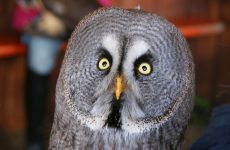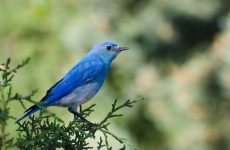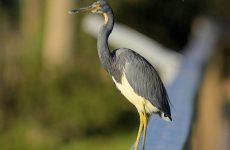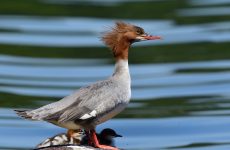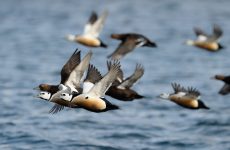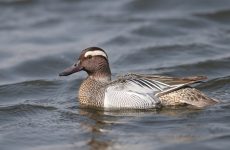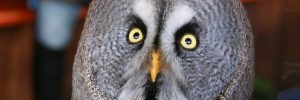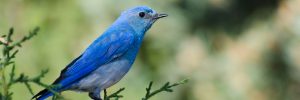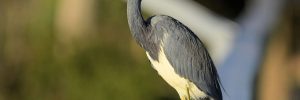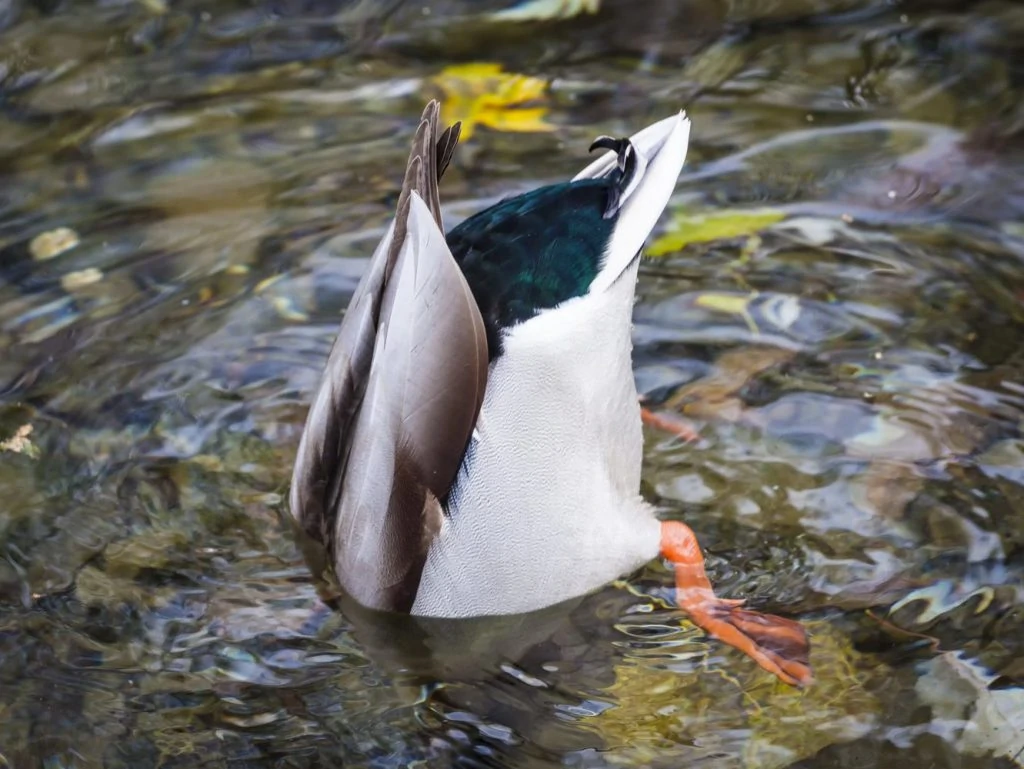
Dabbling ducks are freshwater ducks that feed on the surface of the water or by tipping up their heads into the water and their rears into the air. Rather than diving ducks, which dive under the water to catch fish and other creatures.
They sweep their heads from side to side while taking small ‘bites’ or ‘nibbles’ of the water to filter out plants. They also feed on land for seeds and grain or insects.
There is still some debate about whether some of these ducks should be included in a different subfamily, and these include Wood Ducks, Mandarin Ducks, and Muscovy Ducks.
You can also find out more about ducks and their calls or check out which ducks are in your state or province from the main menu.
18 Types Of Dabbling Ducks
1. Mallard
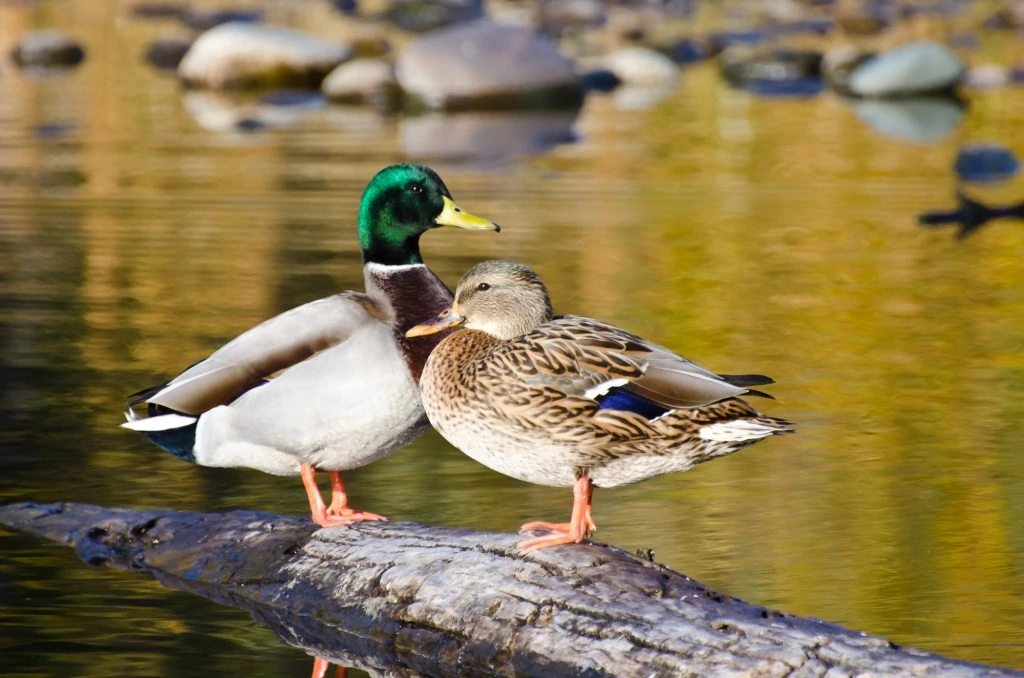
Mallards are large ducks, and the males have striking green heads. They also have bright yellow bills and gray bodies with brown breasts and black towards the tail. They have a curl of tail feathers and a blue patch on the wings bordered with white which is called a speculum.
Females and juveniles are mottled brown with orange bills but still have the blue speculum.
- Anas platyrhynchos
- Length: 19.7 – 25.6 in (50 – 65 cm)
- Weight: 35.3 – 45.9 oz (1000 – 1300 g)
- Wingspan: 32.3 – 37.4 in (82 – 95 cm)
Mallards remain all year in most of the lower 48 and the western coast of Canada and Alaska. Those that breed in Canada and Alaska head south to the southern United States and northern Mexico.
Mallards are one of the most commonly spotted and recognizable ducks that will happily be fed on ponds and rivers. They are dabbling ducks that feed on water plants and do not dive. They are very long-lived, and they have been recorded at 27 years old.
Mallard Calls:
Male Mallards don’t quack, only females do. Instead, the male makes a rasping sound.
Male Mallard Call
Female Mallard Call
Nests of Mallards are on the ground on land but close to the water. They are usually hidden under overhanging grass and made in a depression on the ground, filled with vegetation pulled from the surrounding area.
They lay up to thirteen eggs which take about 3 to 4 weeks to hatch, and the ducklings are ready to leave the nest almost immediately.
Fun Fact: Most domesticated ducks are descended from Mallards, and they have been hunted and bred for food.
2. Wood Duck
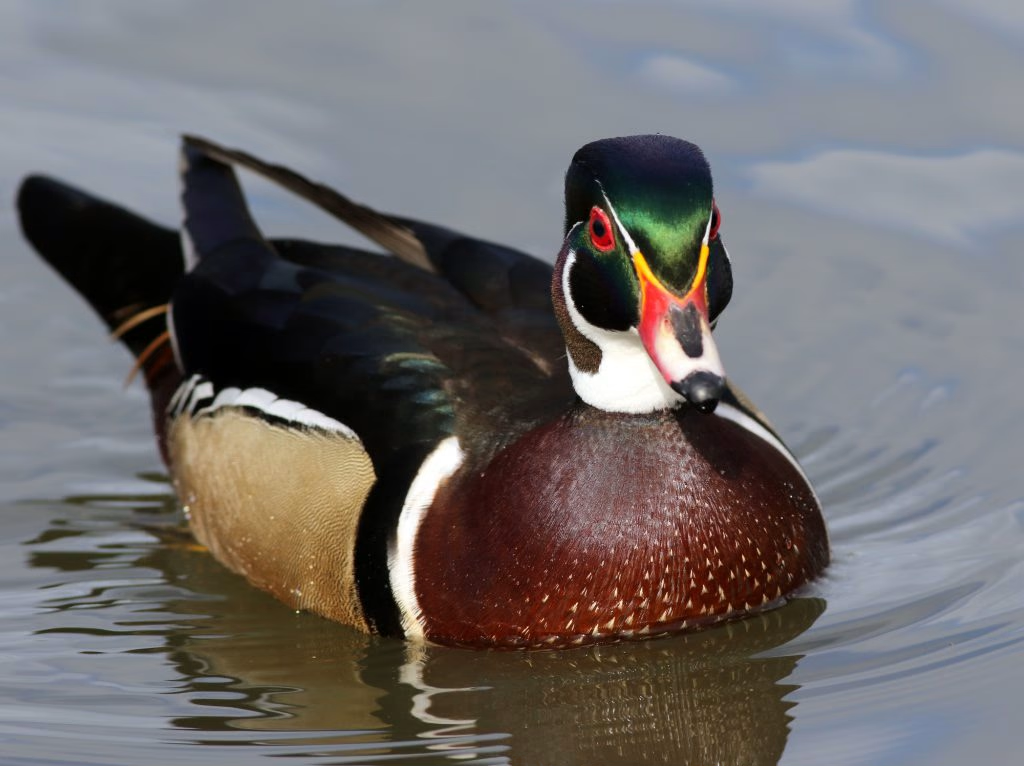
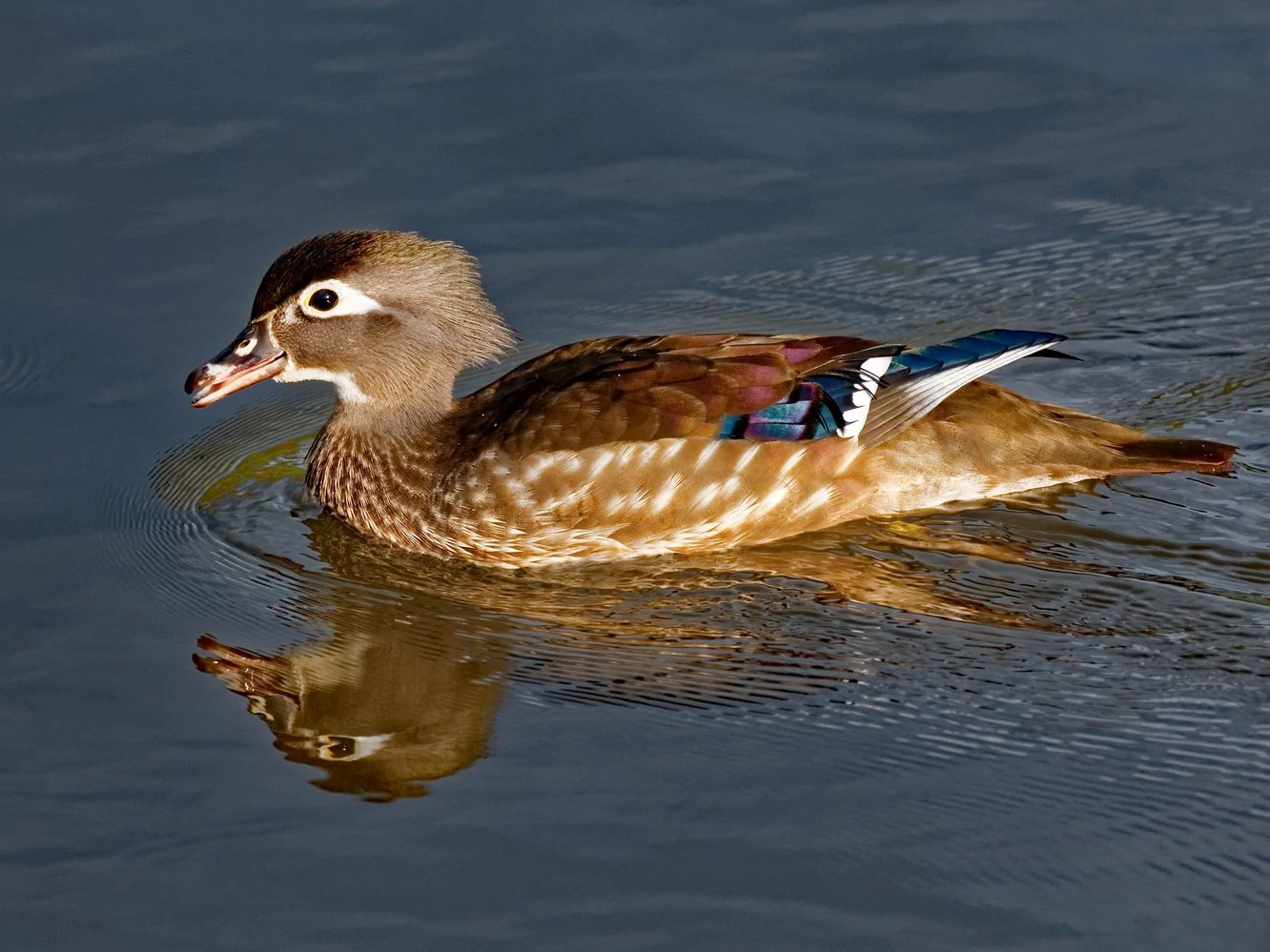
Male Wood Ducks have beautiful green heads with a striking crest at the back and black and white markings, and red eyes. They really are birds with great hairdos.
Their bodies are a checkerboard of colors, with reddish-brown chests, buff sides, brown backs and tails, white markings, and flashes of blue.
Females are brown with grayish-brown heads and white around their dark eyes. They have blue patches called speculum on their wings.
- Aix sponsa
- Length: 18.5 – 21.3 in (47 – 54 cm)
- Weight: 16.0 – 30.4 oz (454 – 862 g)
- Wingspan: 26.0 – 28.7 in (66 – 73 cm)
Wood Ducks are residents of eastern US states and along the Pacific Coast and parts of the northwest. Wood Ducks that breed in the north along the border with Canada migrate for winter to southern US states and Mexico.
You can find Wood Ducks in wooded swamps, and they eat seeds, fruit, and insects, usually in the water, but they will also feed on land in fields and forests.
Wood Ducks Calls:
Male Wood Ducks make a rising whistle, and female Wood ducks make a distinctive 2-note call.
Male Wood Duck call
Female Wood Duck call
Nests of Wood Ducks are usually in tree cavities, very near to water, and may be up to 60 feet off the ground. Females line the nest with down feathers plucked from their breasts. They lay up to sixteen eggs, which take 4 or 5 weeks to hatch, and the young use their clawed feet to climb out before jumping out.
Fun Fact: Female Wood Ducks often lay their eggs in other Wood Duck nests to be raised by others.
3. Gadwall
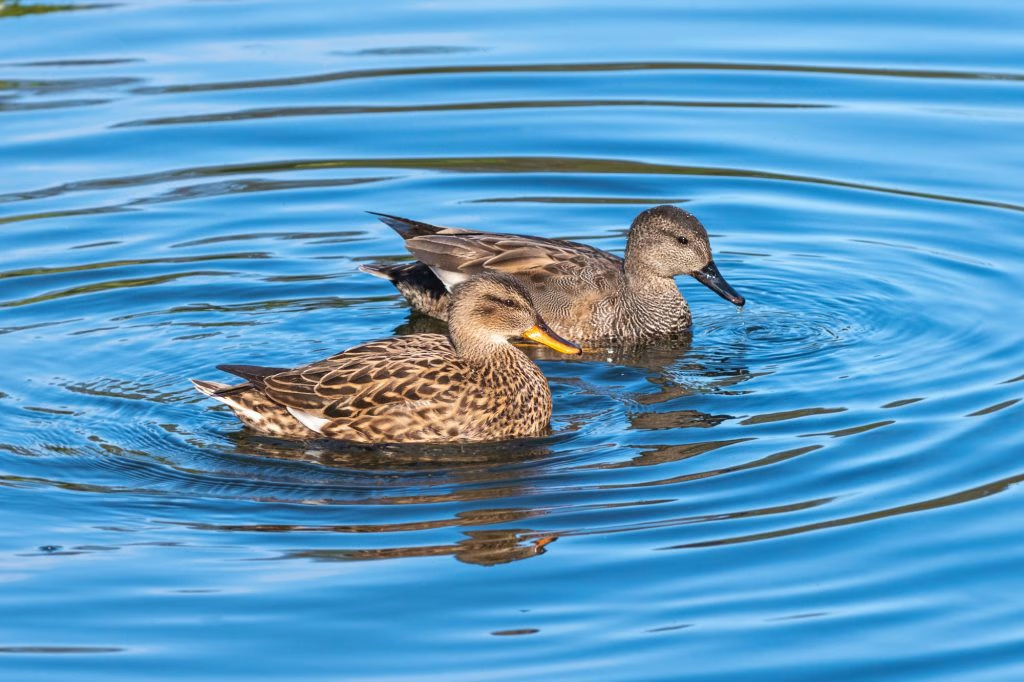
Gadwalls are large dabbling ducks that stand out despite their understated coloring. Compared to other bright and colorful dabbling ducks, Gadwalls are subtly colored with dark-brown heads, black, scaled patterns on the chest and shoulder, gray or white on their bellies, and black bottoms.
When in flight, a small, white patch can be seen on their wings. Females are generally brown all-over, with a more diffused scale pattern on their shoulder, back, chest and bottom.
- Mareca strepera
- Length: 19 – 23 in (48 – 58 cm)
- Weight: 35.27 oz (1000 g)
- Wingspan: 31 – 36 in (79 – 91 cm)
Gadwalls breed in the plains of the United States and Canada before migrating to central and southern US states and Mexico. Some remain all year on the West Coast.
You can find Gadwalls in open wetlands, grasslands, and marshes with dense vegetation. In winter, you can see Gadwalls in saltwater marshes, city parks, reservoirs, and muddy estuaries.
Gadwalls feed themselves by dabbling in shallow water. They submerge their heads until they can reach for plants and other vegetation underwater. They may occasionally feed on insects, too.
Gadwall Calls: Male Gadwalls make short reedy whistles, followed by a quack. Females quack and sound similar to mallards.
Male Gadwall call
Female Gadwall call
Nests of Gadwalls are often hard to find because they’re hidden in dense vegetation near water. They are made with grass and weeds and lined with feathers. There may be as many as fifteen eggs in a nest. The female incubates them for about twenty-seven days until they’re hatched.
Fun Fact: Gadwalls sometimes steal food from other dabbling ducks as they surface from diving.
4. Northern Shoveler
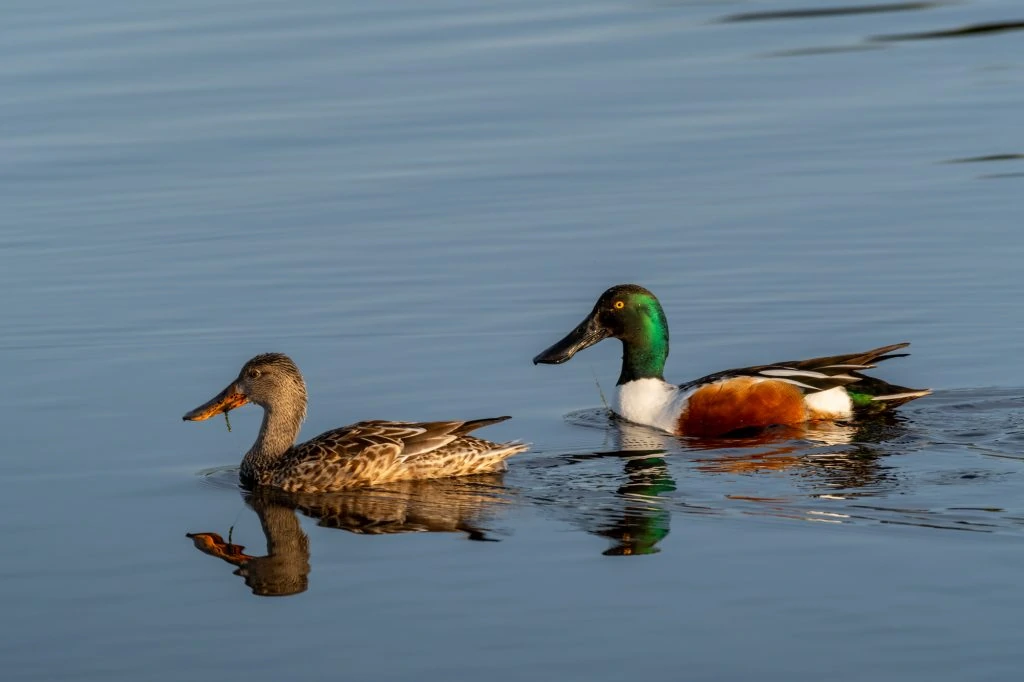
Northern Shovelers are dabbling ducks, and males have green heads and large spoon-shaped black beaks that make them easy to spot. They have reddish-brown sides, white chests, and black backs. Males also have blue patches on the wings.
Females are mottled brown with a blue shoulder patch and large orange beaks.
- Spatula clypeata
- Length: 17.3 – 20.1 in (44 – 51 cm)
- Weight: 14.1 – 28.9 oz (400 – 820 g)
- Wingspan: 27.2 – 33.1 in (69 – 84 cm)
Northern Shovelers spend the winter in the southern half of the US and along the Pacific and Atlantic Coasts up to Canada. They migrate to the western half of Canada and northwestern US states for breeding in the summer. Some also breed around the Great Lakes.
You can find Northern Shovelers in sociable groups in shallow, stagnant water.
Crustaceans, invertebrates, and some seeds make up the diet of shovelers, and they filter them out by stirring up the bottom and swinging their bills from side to side through the water. They then push the water out through comblike projections called lamellae along the edge of their bills, catching any food.
Northern Shoveler Calls: Male Northern Shoveler calls sound like ‘hook-hook’ or ‘took-took’. Females have a nasal quack.
Male Northern Shoveler call
Female Northern Shoveler call
Northern Shovelers nest on the ground in short vegetation close to water. They lay around ten eggs, which take 3 to 4 weeks to hatch. The ducklings are able to walk and swim immediately.
Fun Fact: Northern Shovelers will sometimes form large groups that swim in circles to help stir up the bottom for feeding.
5. Green-winged Teal
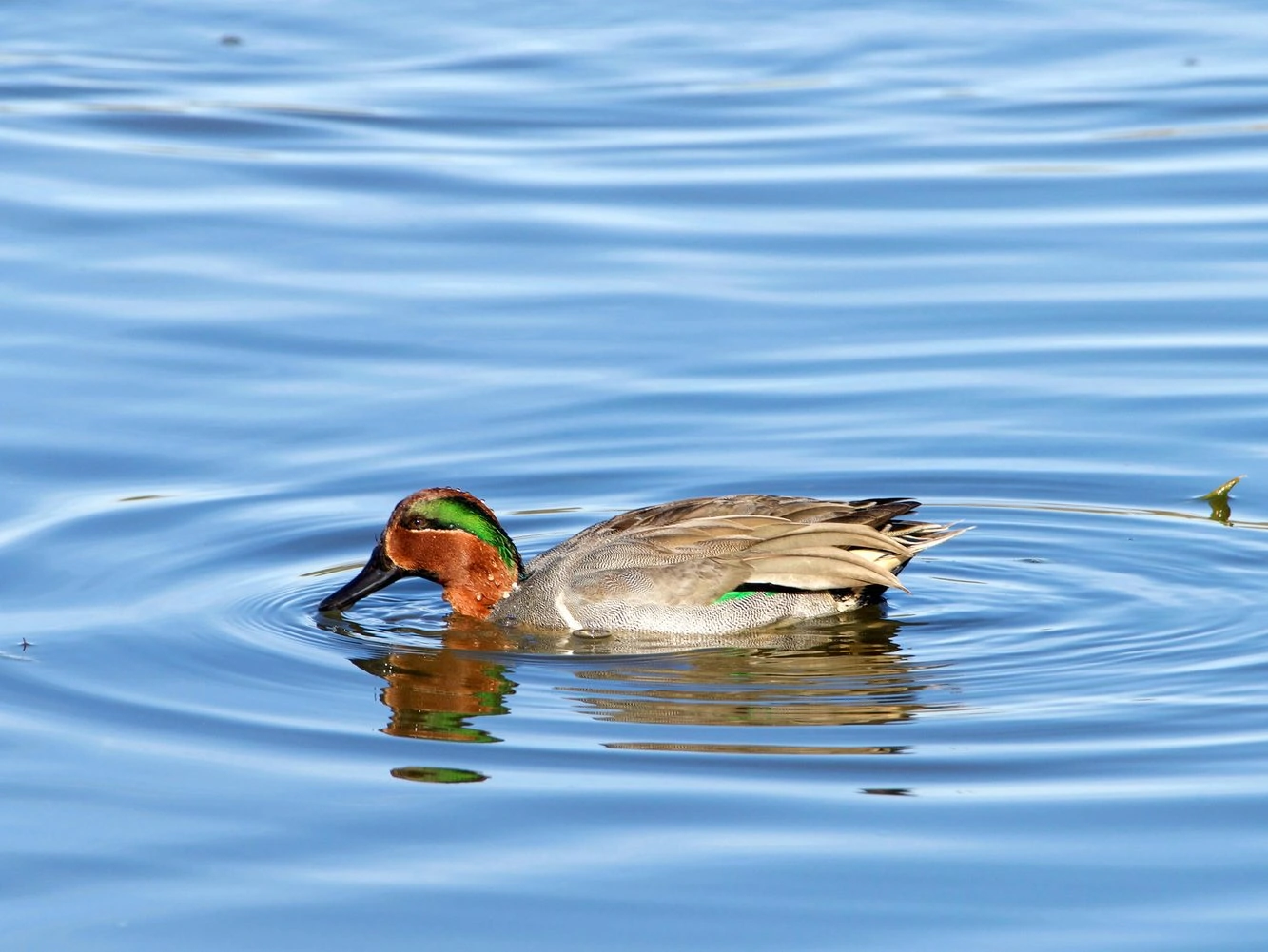
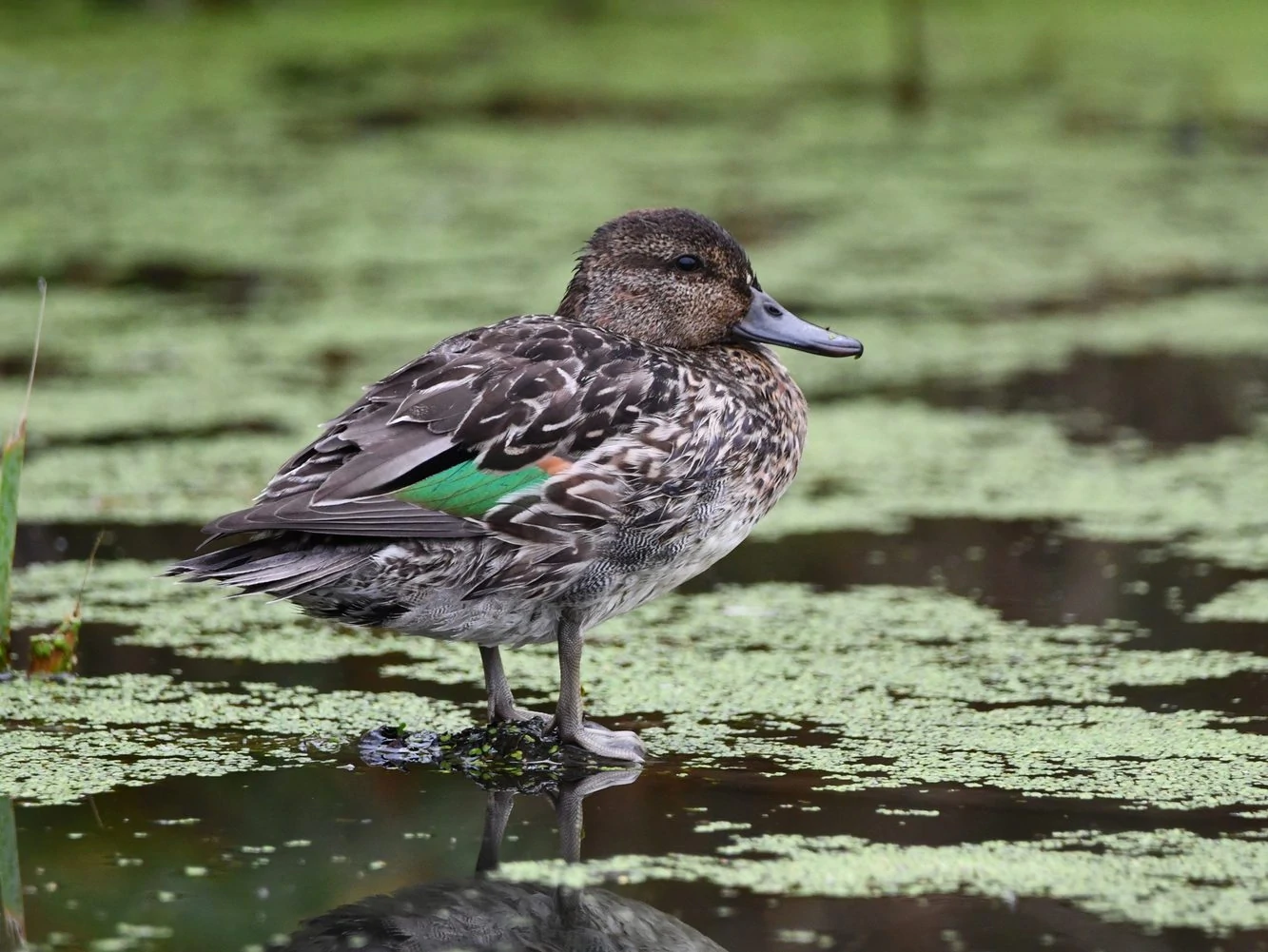
Green-winged Teals are small dabbling ducks. Males have a green stripe along the sides of their heads. The rest of their heads are brown, and they have grayish bodies.
Females are brown with a yellow streak along the tail. Both males and females have a green wing patch.
- Anas crecca
- Length: 12.2 – 15.3 in (31 – 39 cm)
- Weight: 4.9 – 17.6 oz (140 – 500 g)
- Wingspan: 20.5 – 23.2 in (52 – 59 cm)
Most Green-winged Teals migrate from breeding grounds in Alaska, Canada, and northern US states to the southern US states and the Pacific Coast. However, some ducks remain around the Rocky Mountains all year.
You can find Green-winged Teals on flooded ground and shallow ponds in large flocks of up to 50 thousand. They feed on invertebrates and seeds.
Nests of Green-winged Teals are on the ground in dense cover such as grass or thickets.
Green-winged Teal Calls: Male Green-winged Teals whistle and chatter, and females have a high-pitched quack.
Male Green-winged Teal
Female Green-winged Teal
Nests of Green-winged Teals are on the ground in meadows and grasslands and near water. They lay up to nine eggs, which take around three weeks to hatch. The ducklings are ready to leave the nest almost immediately.
Fun Fact: Green-winged Teals don’t need to run across the surface of the water to take off. They can fly straight away as they are so agile.
6. American Wigeon
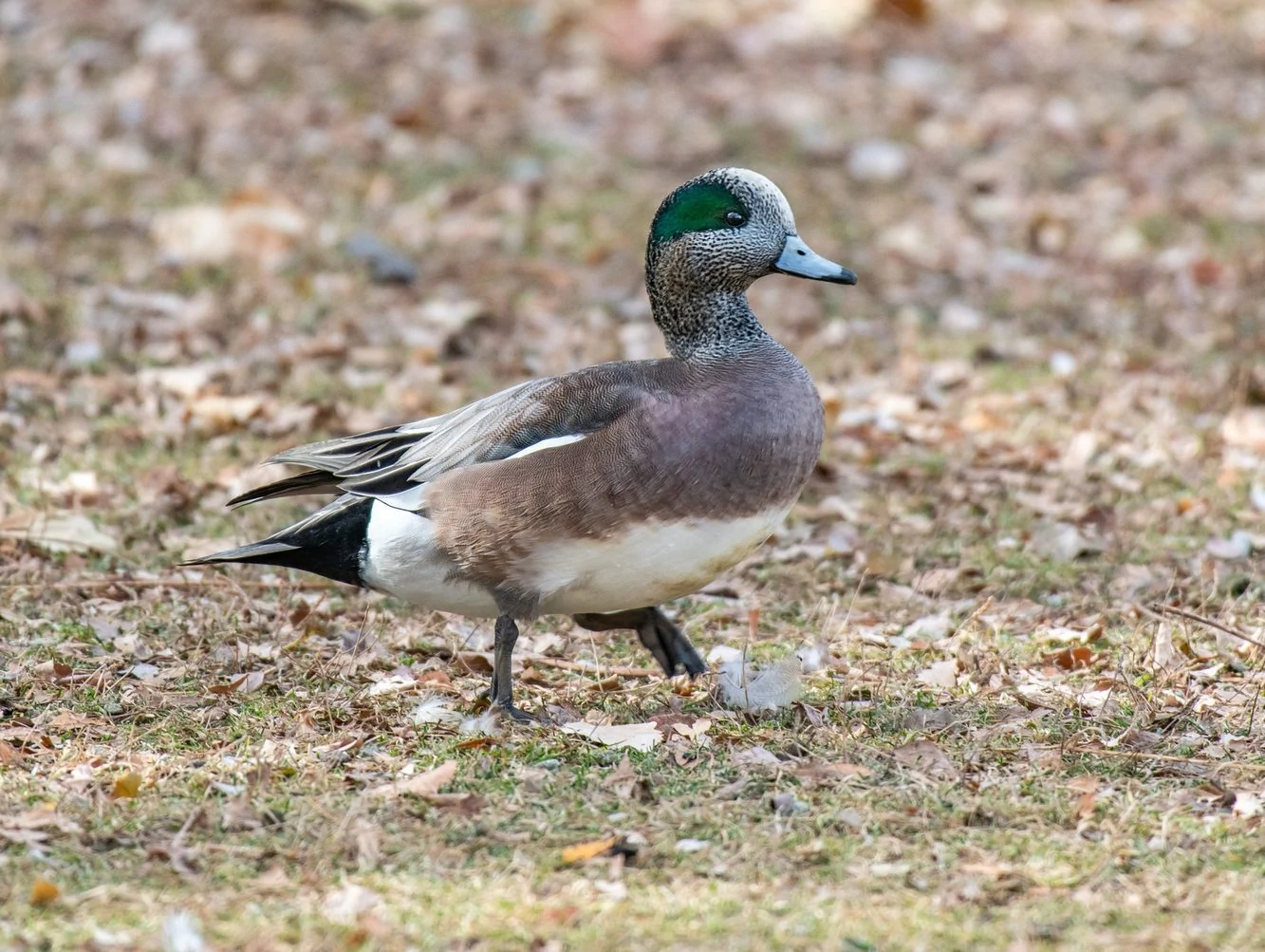
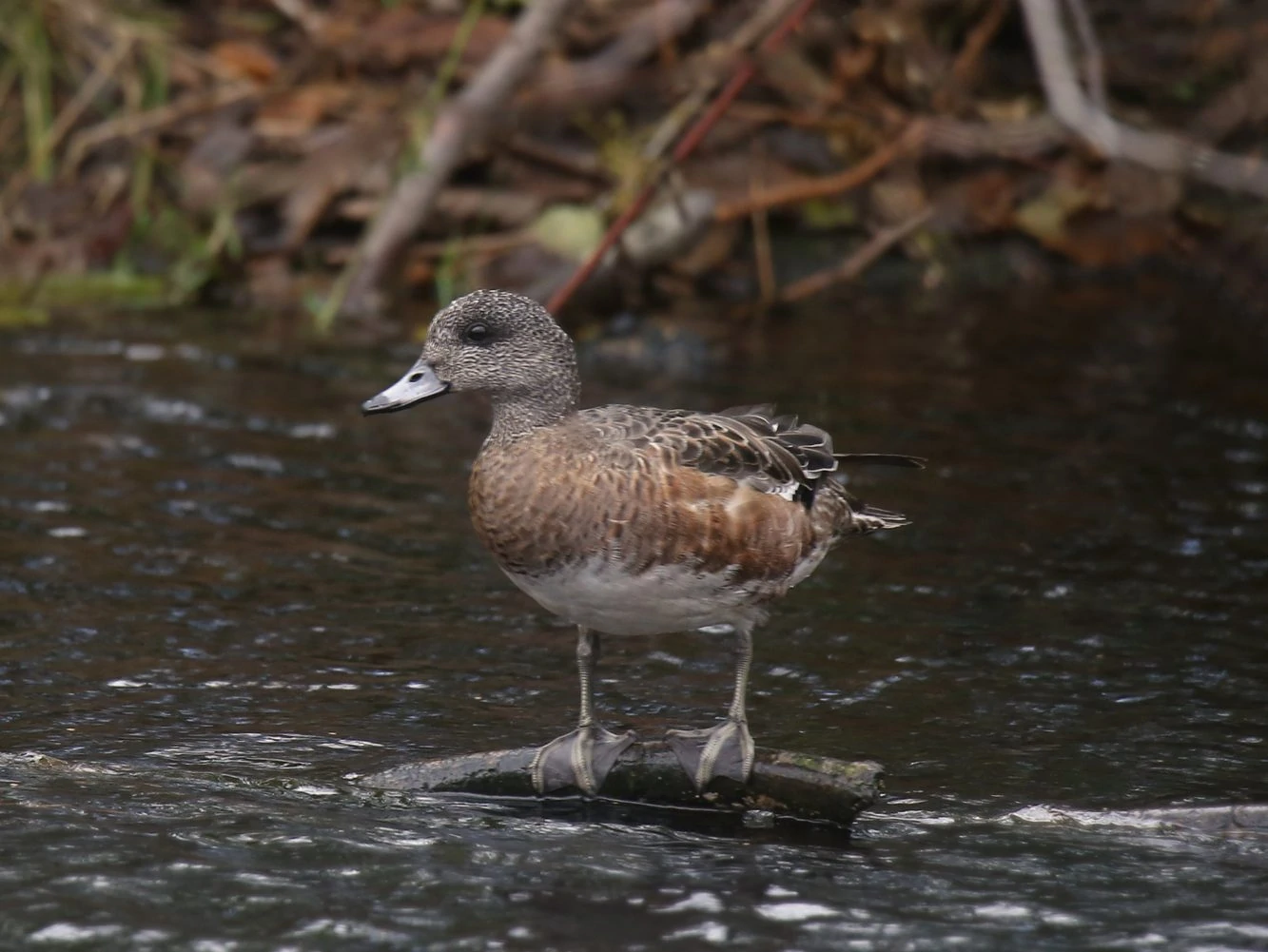
American Wigeons are small ducks with green stripes on the sides of their heads and with white caps on the males. The rest of them are grayish-brown.
Females are brown with grayish-brown heads. Male and females both have pale beaks.
- Mareca americana
- Length: 16.5 – 23.2 in (42 – 59 cm)
- Weight: 19.1 – 46.9 oz (540 – 1330 g)
- Wingspan: 33.1 in (84 cm)
American Wigeons breed predominantly in Alaska, western Canada, and northwestern US states. They spend the winter in the southern and central US states and along the Pacific and Atlantic coasts.
You can find American Wigeons feeding on vegetation both in the water and on the land in wetlands, fields, and ponds. They will also eat insects and invertebrates.
American Wigeon Calls: Male American Wigeons give a high-pitched whistle, and females make a harsh grunt.
Male American Wigeon call
Female American Wigeon call
Nests of American Wigeons are on the ground, far from water in fields and grasslands. The female lines the depression in the ground with grass, reeds, and down feathers, then they lay up to 13 eggs which take 2 to 3 weeks to hatch. The ducklings leave the nest almost immediately.
Fun Fact: American Wigeons are known as ‘baldpate’ because their white stripe looks like a bald man’s head.
7. Blue-winged Teal
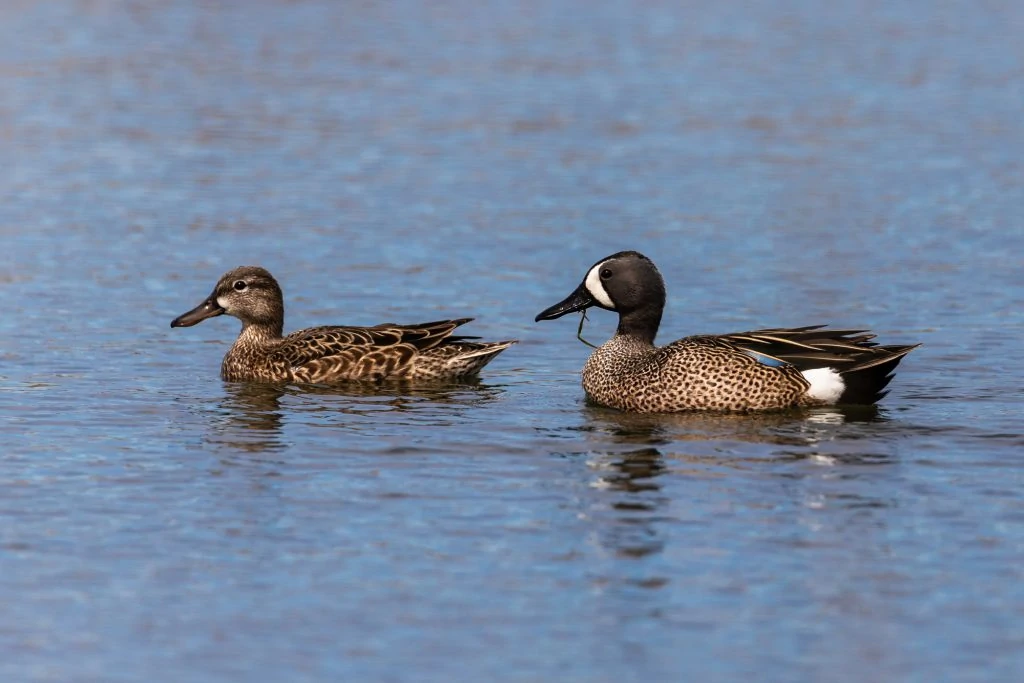
Blue-winged teals are small ducks from the Anatidae family. Their head is bluish-gray with a white crescent in front of their eyes. Their body is spotted brown from the chest to the tail.
When their wings are unfurled, there is a distinct blue patch on the shoulders bordered with green and white. Females have the same scaly, brown pattern on their bodies, but they have no distinctive white markings on their faces.
- Spatula discors
- Length: 15 – 17 in (38 – 43 cm)
- Weight: 19.18 oz (544 g)
- Wingspan: 23 -31 in (58 – 79 cm)
Blue-winged Teals breed in the US and Canada before migrating to Florida, the Gulf Coast, southern West Coast, Mexico, Central and northern South America, and the Caribbean.
You can find Blue-winged Teals on shorelines with calm or sluggish water, so lakes and ponds with protruding trees and rocks are perfect. They also live around shallow water sources with abundant vegetation, like marshes and swamps. During the breeding season, you’ll find them in northern prairies and parklands.
Blue-winged Teals mostly eat aquatic plants that they find on the surface of their water. They may also eat aquatic insects, particularly during the breeding season.
Blue-winged Calls: They make high-pitched chattering calls, and females also quack.
Blue-winged Teals chattering calls
Female Blue-winged Teal Quack
Nests of Blue-winged Teals are often found in a hollow in the ground, sheltered behind tall grasses and near a water source. They are built from grass and weeds and lined with down.
Females lay up to fifteen eggs that they incubate for 2 to 3 weeks. The young ducklings may be able to walk a few hours after hatching, but they can only fly after six to seven weeks.
Fun Fact: Because of their long, over-ocean migration patterns, Blue-winged Teals have the highest mortality rate among dabbling ducks.
8. American Black Duck
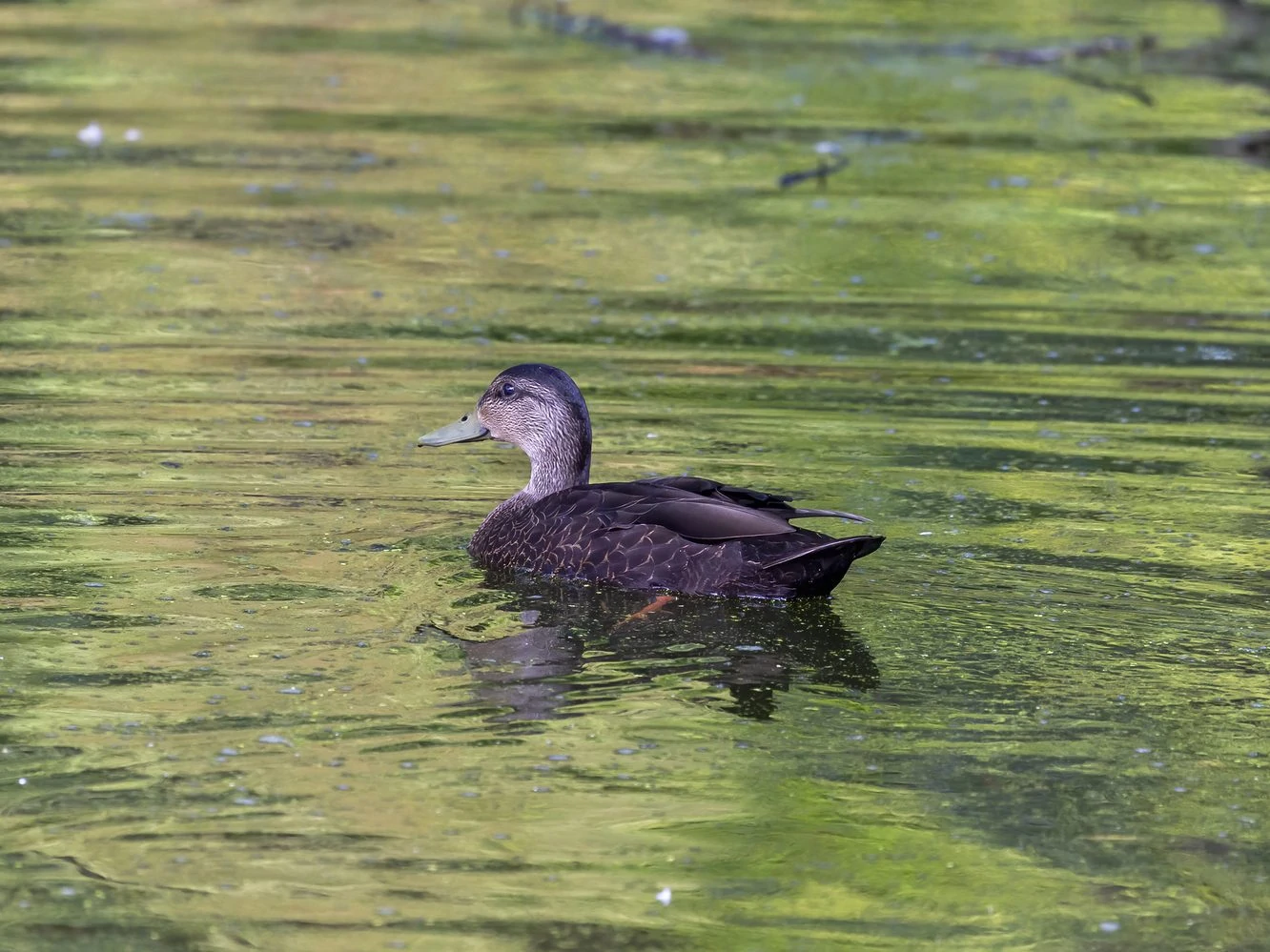
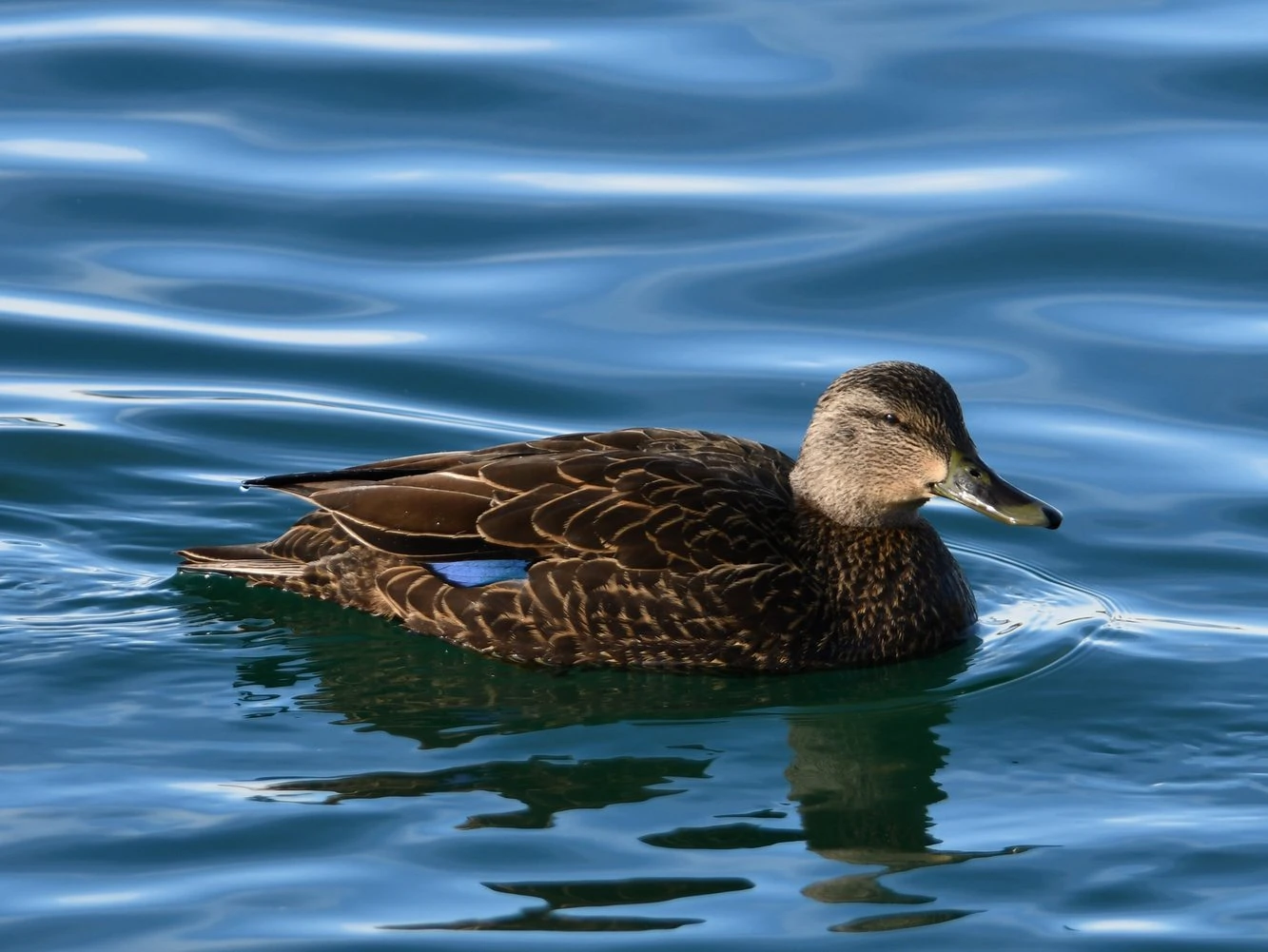
American Black Ducks are large, heavy ducks from the Anas family. They’re quite possibly the heaviest ducks in the species. Males and females have the same dark brown bodies and pale brown heads. Males have a yellow bill, and females have an olive one. The only bright colors on their bodies are the blue-purple patch on their wings and their red-orange legs.
- Anas rubripes
- Length: 19 – 23 in (48 – 58 cm)
- Weight: 49.6 oz (1406 g)
- Wingspan: 33 – 36 in (84 – 91 cm)
American Black Ducks are found in eastern regions. They breed in eastern Canada and spend the winter in eastern US states. Some remain all year in northeastern US states.
You can find American Black Ducks in many different habitats. Ordinarily, they inhabit salt marshes, lakes, ponds, and estuaries. They are also seen in forested swamps, beaver ponds, agricultural fields, and flooded woods. Also, they may reside in tidal marshes, and when they want to hide from hunters, they stay on conservation land.
American Black Ducks can look for food on both land and water. Aside from dabbling, they also graze on land. They eat aquatic vegetation, animals like snails, insects, mussels, small fish, and grasses and seeds from fields.
American Black Duck calls: Male American Black ducks have a more reedy call than the females’ loud quack.
Male American Black Duck
Female American Black Duck
Nests of American Black Ducks usually have six to fourteen eggs that both parents care for. However, the male will leave the responsibility to the female when they reach the 2nd half of the incubation period.
Incubation usually takes twenty-six days, and the newly-hatched chicks are brought to the water to learn to forage for food. It takes another six weeks for the young to learn how to fly.
Fun Fact: 11,000-year-old fossils of American Black Ducks have been discovered in Florida and Georgia.
9. Northern Pintail
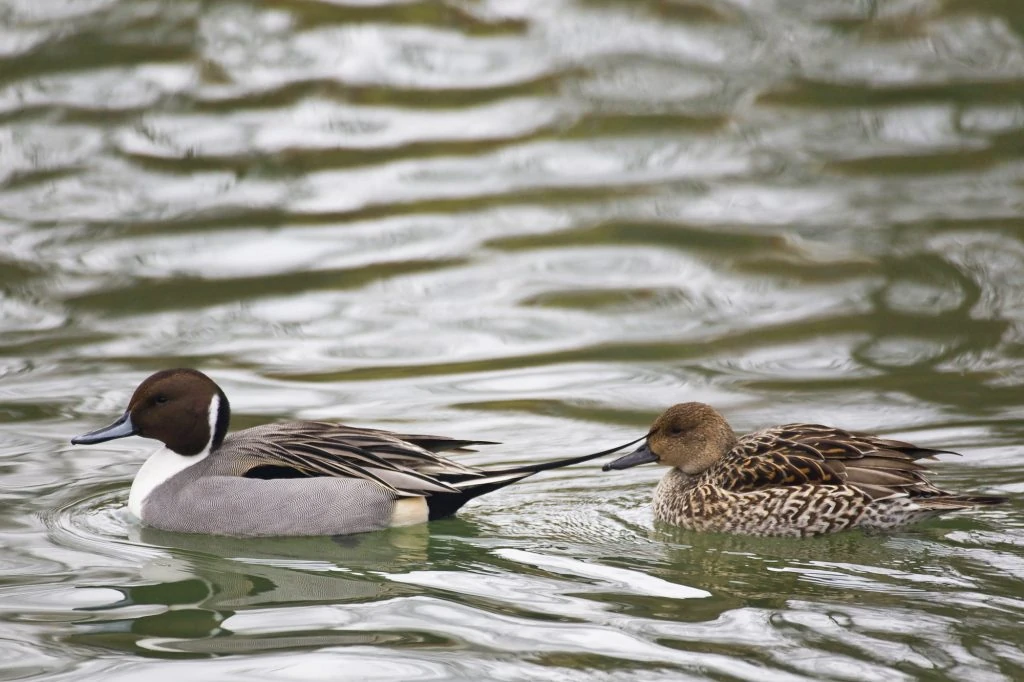
Northern Pintails are ducks known for their long pointy tails. Males have a beautiful brown head, with a contrasting white vertical stripe down their neck. Their bodies are white, and they have gray, white, and black patterns on their back. When in flight, their wings display a green patch.
Females are brown with intricate scaled patterns on their bodies. They also have a brown patch on their wings.
- Anas acuta
- Length: 20 – 26 in (51 – 66 cm)
- Weight: 36.33 oz (1030 g)
- Wingspan: 29 – 35 in (74 – 89 cm)
Northern Pintails breed in Canada, Alaska, and the Midwest before migrating to southern and coastal US states.
You can find Northern Pintails living with other duck species in open wetlands, marshes, prairies, and even in agricultural fields. They forage on the edges of lakes and ponds but are known to dabble in open water with other ducks. During winter, they will migrate to coastal lagoons, sheltered estuaries, and brackish marshes.
Northern Pintails have a distinct advantage over ducks when dabbling for food. With their long necks, they can reach 12 inches deep into the water, much further than other ducks. They feed on seeds and roots of aquatic vegetation. They also eat seeds and grain from agricultural fields. During the breeding season, they eat more animals for protein, like aquatic insects and mollusks such as snails.
Northern Pintail calls:
Male Northern Pintail
Female Northern Pintail
Nests of Northern Pintails are usually found in shallow hollows on the ground, close to a water source. They are made with grasses and feathers and serve as home to at least twelve eggs.
The female incubates them for as many as twenty-five days and will lead the young to the water as soon as they’re hatched so they can feed on insects by themselves. They can fly in about fifty days but will not leave the nest until the female has completed molting.
Fun Fact: Because Northern Pintails are agile and speedy birds, they are often hunted as a challenge in game shooting.
10. Cinnamon Teal
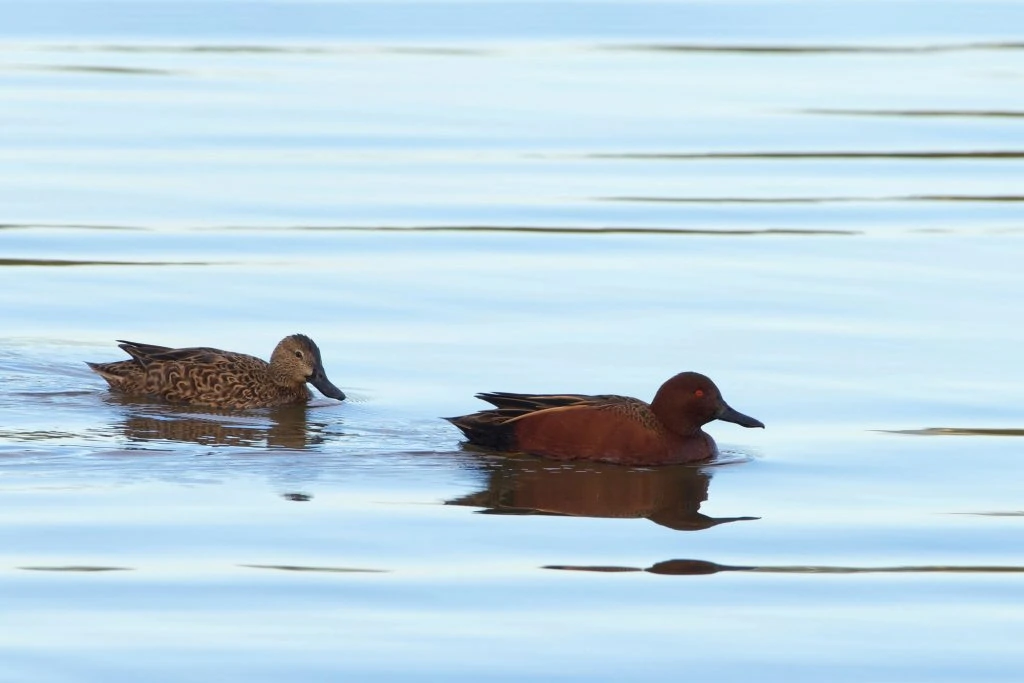
Cinnamon Teal breeding males are the reason why these birds are named as such. They’re cinnamon-colored all over during the breeding season, and even their eyes are red. On their backs, they have a scaly reddish-brown patch. They have a pale blue shoulder, and a white line that separates it from the greenish lower wing.
Males will molt this glossy coloring and will then look similar to the females in winter. Females are brown with a scaly pattern on their chest, belly, and back.
- Spatula cyanoptera
- Length: 14- 17 in (36 – 43 cm)
- Weight: 16.4 oz (465 g)
- Wingspan: 24 – 30 in (61 -76 cm)
Cinnamon Teals breed in western US states and southwestern Canada before migrating for winter to Mexico and South America. Some ducks remain all year in southwestern US states, Mexico, and South America.
You can find Cinnamon Teals in freshwater marshes and ponds. Cinnamon Teals belong to the Dabbling Duck family, so they live on food that they can find by skimming the surface of the water, especially in shallow water. They eat seeds, plants, and aquatic insects. They may opt to dabble just below the surface for submerged plants in deeper waters.
Cinnamon Teal calls:
Male Cinnamon Teal
Female Cinnamon Teal
Nests of Cinnamon Teals are built on the ground, usually sheltered among tall grasses and vegetation but still near the water. The nests are made with grass made even softer with down. There can be up to twelve eggs in a nest, and it takes up to twenty-five days for the eggs to hatch. After about 50 days, the young are able to fly on their own.
Fun Fact: Cinnamon Teals change breeding partners every year.
11. Muscovy Duck
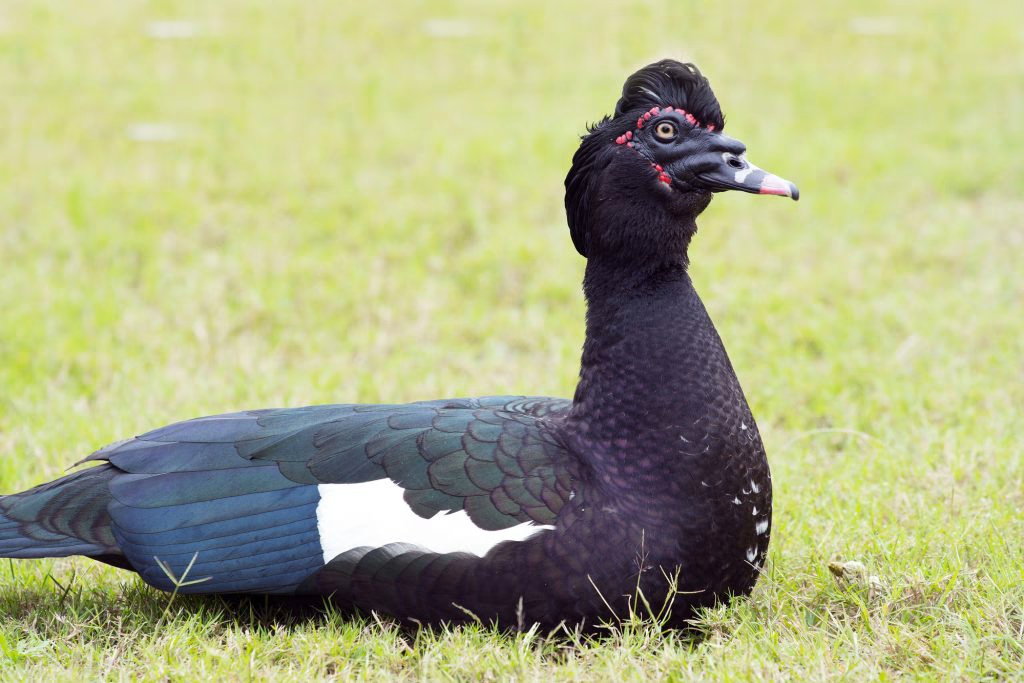
There are wild and domesticated Muscovy Ducks. Wild ducks are glossy, dark-colored, and with a less-obvious white wing patch. Males have a short crest on the nape.
Domesticated Muscovy Ducks may show a varied combination of dark brown, white, and black coloring. Both types of Muscovy Ducks have the same red, wart-like spots on their faces.
- Cairina moschata
- Length: 25 – 35 in (64 – 89 cm)
- Weight: 102.4 oz (2902 g)
- Wingspan: 54 – 60 in (137 – 152 cm)
Muscovy Ducks are predominantly from Mexico, Central America, and South America. However, escaped domesticated Muscovy ducks can be found in many areas.
You can find wild Muscovy Ducks in forests with a water source. Domesticated Muscovy Ducks live on farms and parks.
Wild Muscovy Ducks fend for themselves by wading in shallow wetlands for food. Domesticated Muscovy Ducks are comfortable being fed by humans in parks. They like “dipping” for seeds and plants.
Muscovy Duck call:
Nests of Muscovy Ducks can be found in tree hollows. They also like nest boxes. A female lays about ten eggs which she incubates by herself for a little more than a month. After birth, the female takes care of her newborns for an additional ten to twelve weeks.
Fun Fact: Muscovy Ducks have been domesticated for a long time because their meat has a stronger taste than other ducks.
12. Eurasian Wigeon
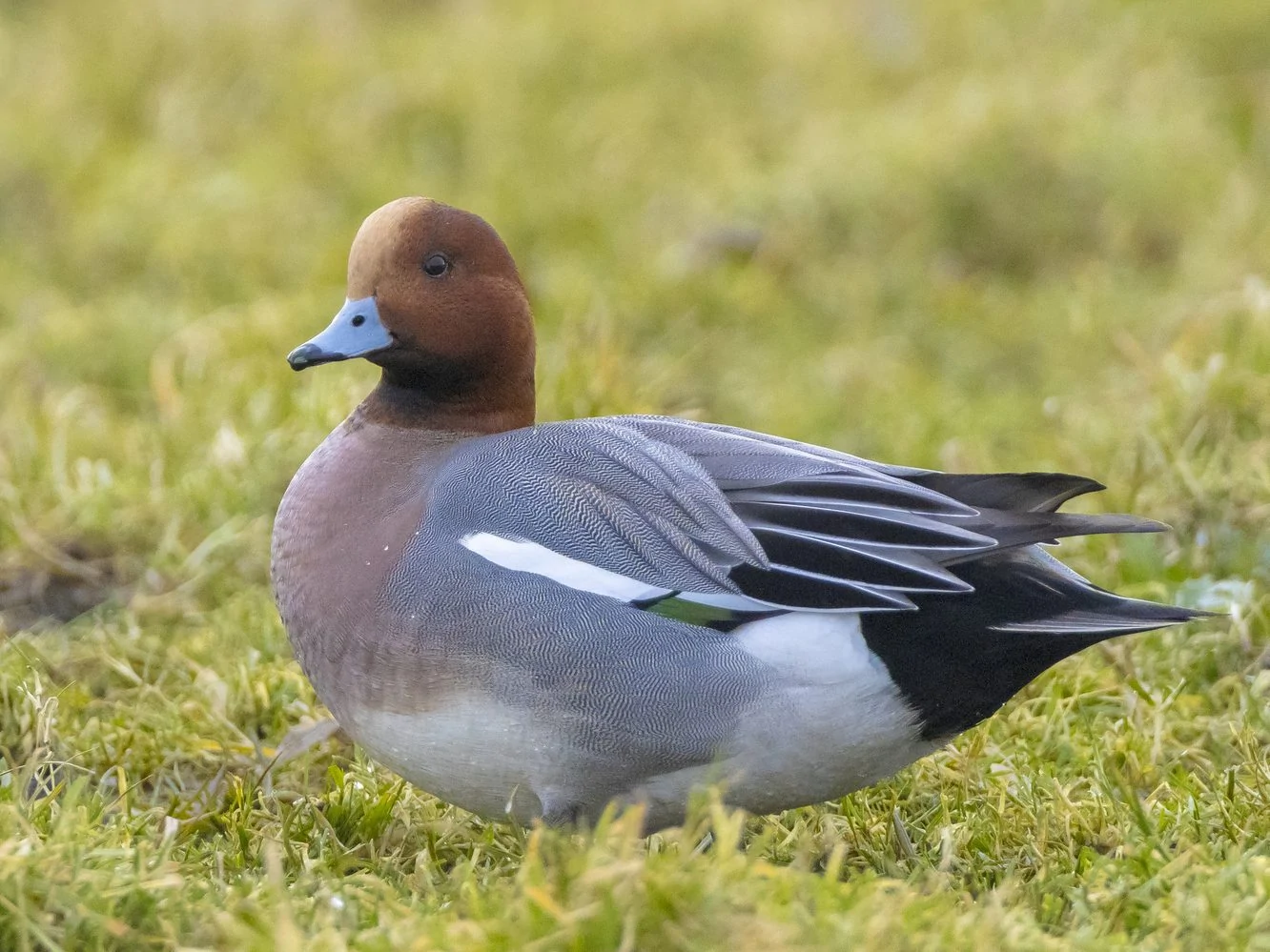
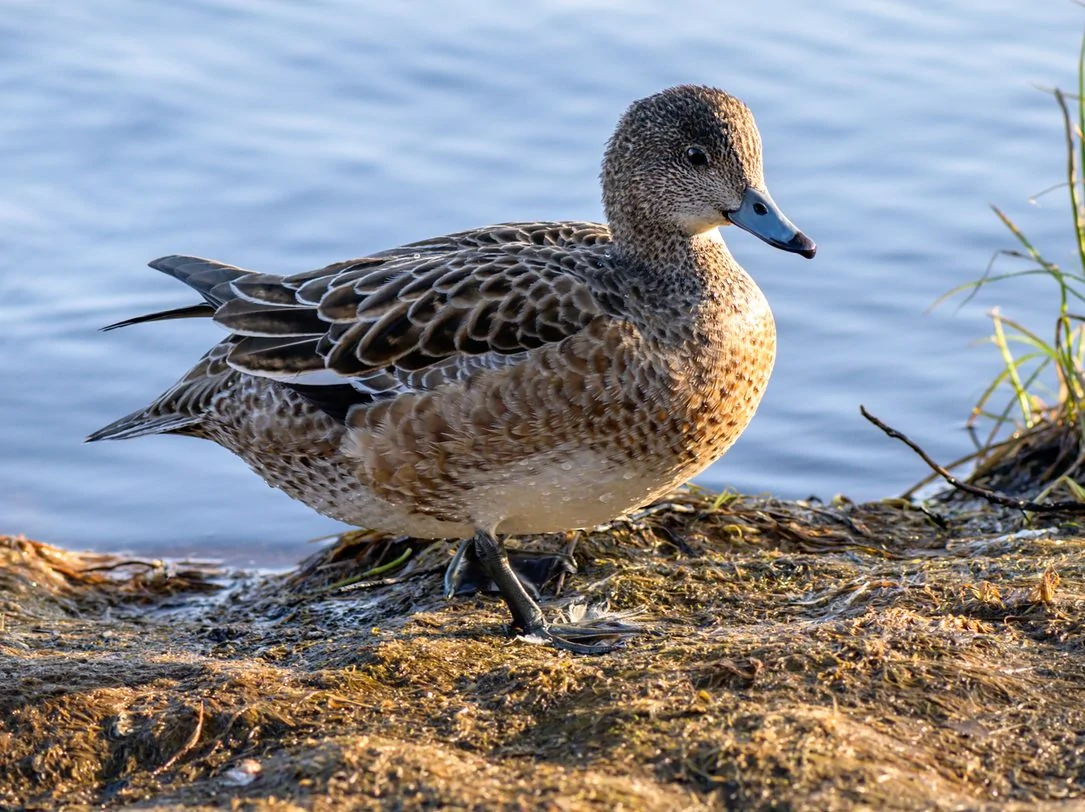
Eurasian Wigeons stand out among dabbling ducks because of the bright, creamy patch on their heads that contrasts with their cinnamon-red head and blue-gray bill. Their backs are gray as well as their sides. They have pinkish breasts, and their wings have white shoulder patches with a green layer at the bottom. Females are mostly brown, with scaly patterns all over and white bellies.
- Mareca penelope
- Length: 18 – 20 in (46 – 51 cm)
- Weight: 35.27 oz (1000 g)
- Wingspan: 30 – 32 in (76 – 81 cm)
Eurasian Wigeons can sometimes be spotted during winter in the US in a few areas.
You can find Eurasian Wigeons on wet grasslands, tidal flats, marshes, ponds, and lakes. Eurasian Wigeons usually join other dabbling ducks when they forage for food. They eat aquatic vegetation that is either submerged or just below the surface of the water.
Eurasian Wigeons also like to relax on land, and they are known to snatch food from other ducks as they surface from feeding.
Eurasian Wigeon calls:
Nests of Eurasian Wigeons are usually in shallow holes in the ground, protected by tall grasses and weeds. Females create the nests using grass and feathers and are often near the water. Females lay from seven to nine eggs. They incubate them for about twenty-five days, and then it takes around two months before the young can fly.
Fun Fact: The “Penelope” in the Eurasian Wigeon’s scientific name comes from Greek Mythology, after Odysseus’ wife, who was rescued by a duck when she was thrown into the ocean.
13. Mexican Duck
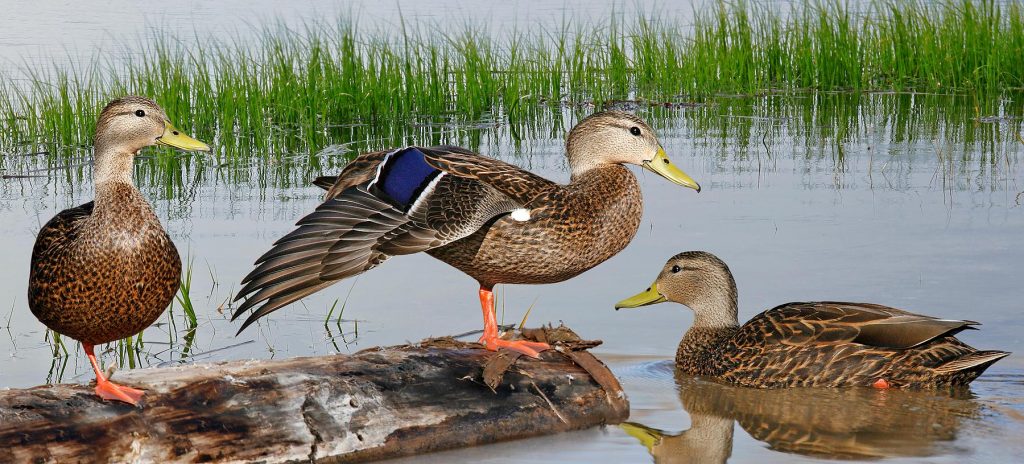
Nests of Mexican Ducks are normally found on the ground or riverbanks, hidden among tall grasses. The nests are made of grasses and lined with feathers. Females lay between four to nine eggs at a time and will wait for about twenty-six days for them to hatch.
Fun Fact: Mexican Ducks used to be on the Endangered Species List in the late 1960s but were removed in 1978. Today, they are in danger again because of the destruction of their habitat and over-hunting.
14. Mandarin Duck
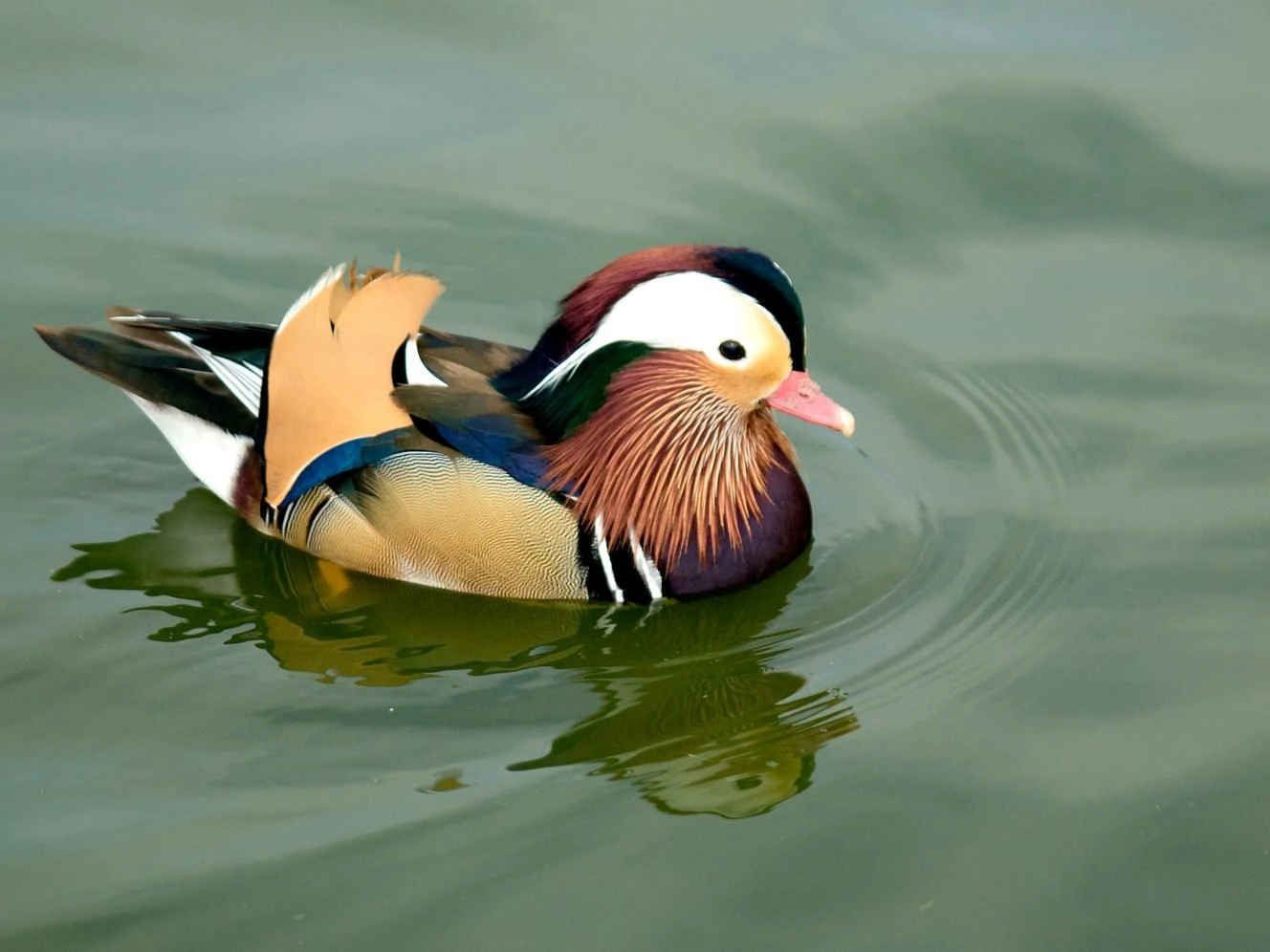
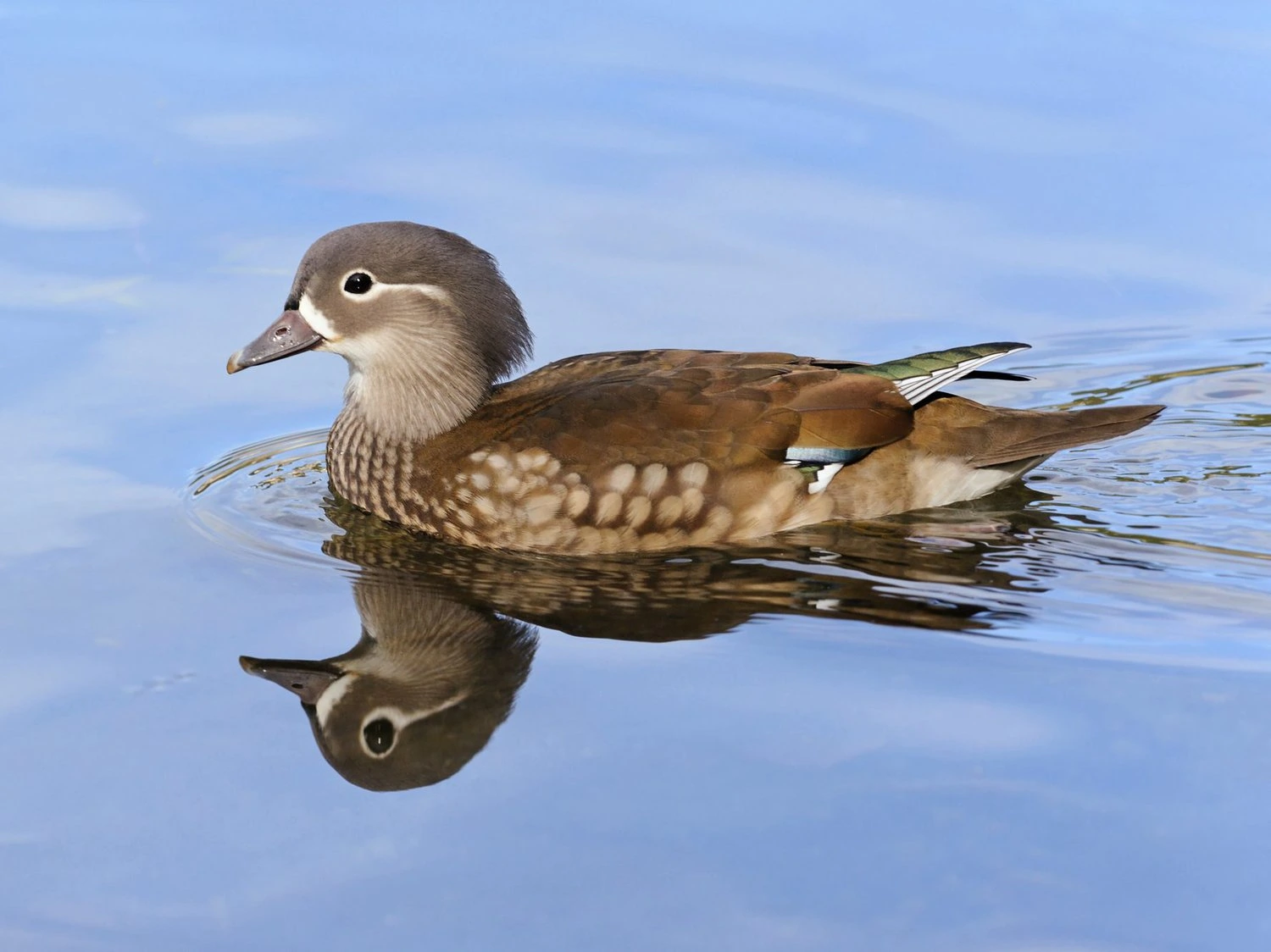
Male Mandarin Ducks are striking and extremely colorful and may be the reason why they’re often bred in captivity. They are a patchwork of color and have a long crest and throat feathers and orange ‘sail’ feathers that stick up at the rear.
During molting, the males resemble the females, but their bill is red, they don’t have a crest, and they have a less visible eye stripe.
Female Mandarin Ducks are pretty subdued compared to the males. Their heads are brownish-gray, with blue bills. Their bodies are mainly brown.
- Aix galericulata
- Length:16 – 19 in (41 – 49 cm)
- Weight: 15 – 24 oz (430 – 690 g)
- Wingspan: 26 – 30 in (65 – 75 cm)
Mandarin Ducks are originally from East Asia but have found their way to the United States after escaping captivity and then reproducing in the wild.
You can find Mandarin Ducks in dense woodland and forest edges near water when in their native habitat. In other areas, they are seen in marshes, coastal lagoons, lake edges, water meadows, and cultivated, wooded areas.
You may also spot them perched in trees, as they are one of the rare ducks that do.
Mandarin Ducks are omnivorous, which means they eat both plants and animals, and this changes depending on the season. In winter, they may have a limited diet of acorns and grains. In spring, they eat insects, snails, fish, and aquatic plants, and summer brings more choices like small fish, frogs, mollusks, and snakes.
Mandarin Duck calls:
Male Mandarin Duck
Female Mandarin Duck
Nests of Mandarin Ducks are found in cavities in trees that are close to water sources. They often use abandoned woodpecker nests but have been known to use nest boxes as well. The female lays between seven to fourteen eggs which she incubates for up to thirty days. The male guards the female and the nest but nothing more than that.
Fun Fact: In China, Mandarin Ducks are regarded as signs of fidelity and so are given as gifts at weddings. However, they are not monogamous and form new pairs each year!
15. Garganey
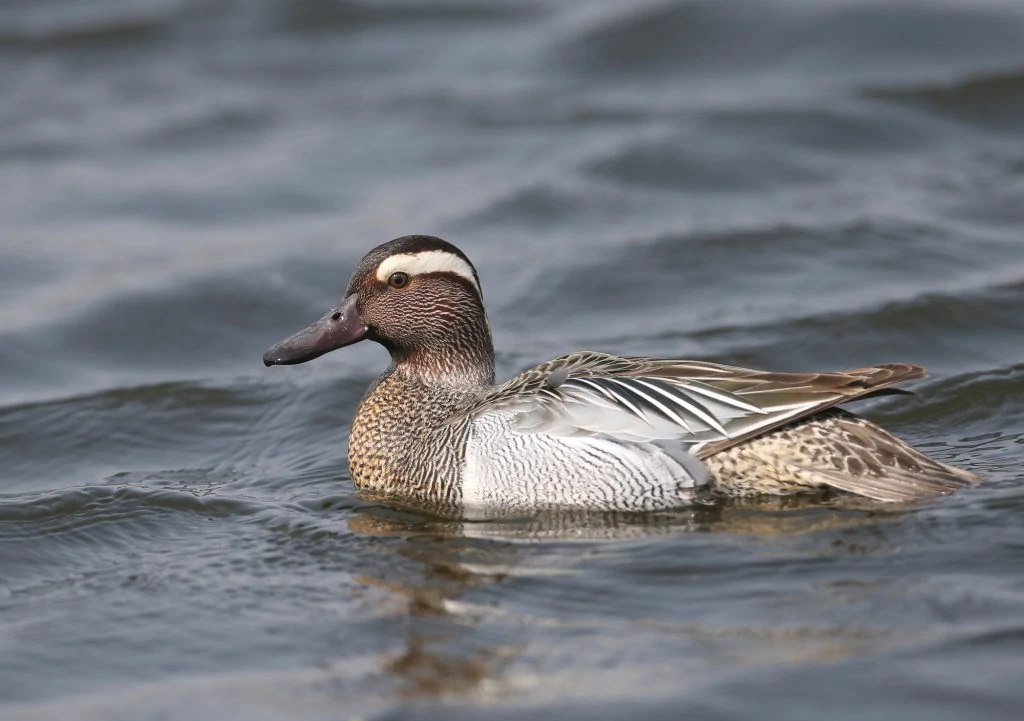
Garganeys are small dabbling ducks. The males are interestingly multi-patterned. The top of their head has a black line running to their neck, while a striking white line above the top of their eye weaves its way down to their back.
Their face and throat are brown and uniquely lined. Their back is striped gray, black, and white. Their belly is grayish-white. When in flight, a green or blue line with white borders appears on their wings.
Female Garganeys have different feather patterns. They have no vertical stripe from the eye. They are mostly dark brown all over, with a scaly pattern on their back, chest, and belly.
- Spatula querquedula
- Length: 14 – 16 in (36 – 41 cm)
- Weight: 18.34 oz (520 g)
- Wingspan: 23 – 25 in (58 – 64 cm)
Garganeys usually breed in Eurasia and winter in Africa and southern Asia, but some wander into Alaska.
You can find Garganeys around shallow freshwater lakes, reedy wetlands, and marshes with abundant vegetation on the edges.
Garganeys mostly feed on aquatic plants and insects. With their spatula-like bill, they are able to filter the water that passes through their bill to get at their food.
Garganey call:
Male Garganey
Female Garganey
Nests of Garganeys are often found on the ground close to shallow ponds and lakes filled with floating plant vegetation. Their nests are made with grass and plants that are hidden behind tall shrubs. There are about seven eggs per nest that the female incubates by herself. It takes twenty-four days for the eggs to hatch.
16. Falcated Duck
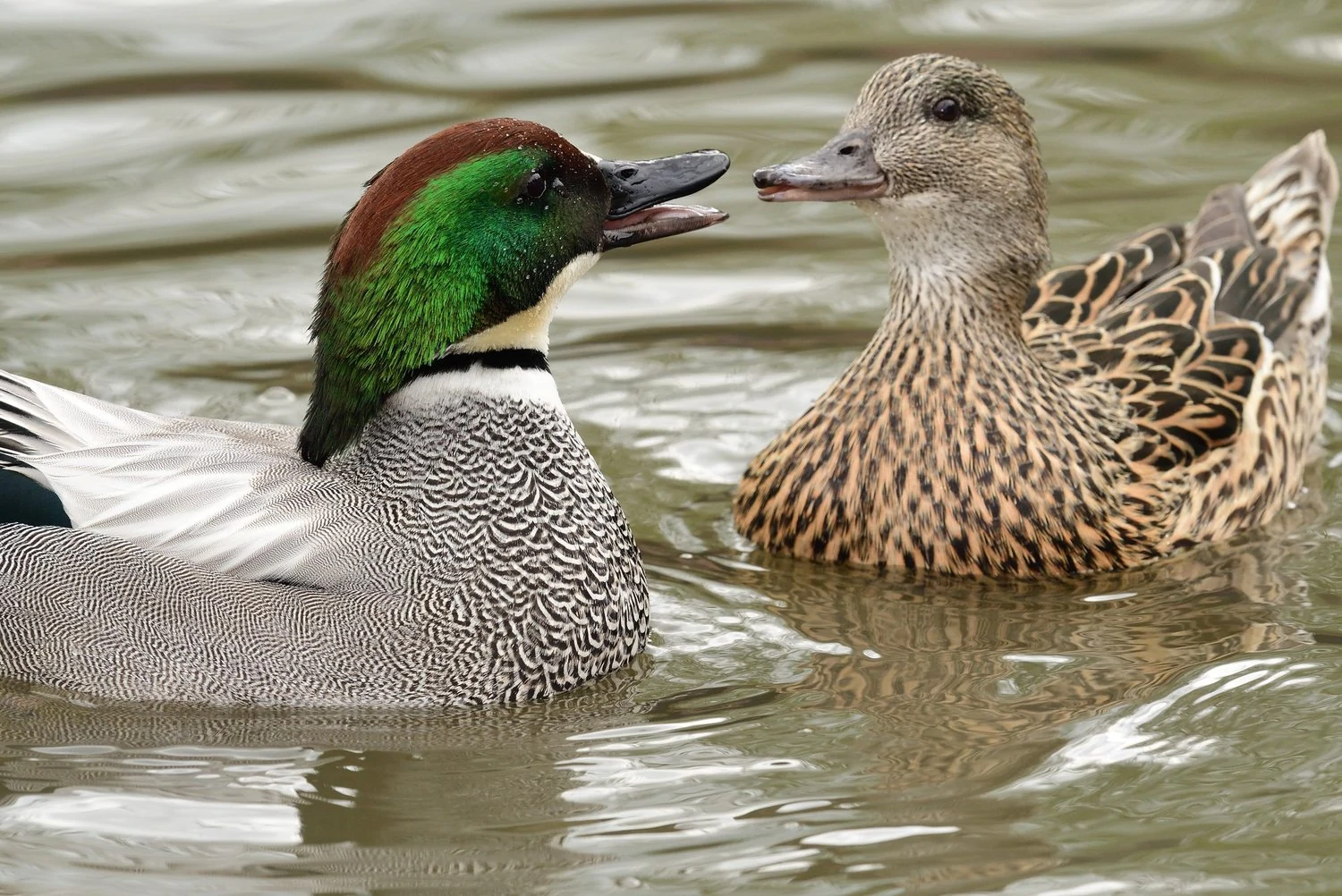
Male Falcated Ducks are instantly recognizable because of their glossy, red-brown, and green heads. Their throats are white with a distinct black “necklace” around them. Their bodies are mostly gray, with distinct black and white patterns.
On their breasts, they have scaled patterns. On their flanks and bellies, they have finer, scalloped patterns. They also have sickle-shaped feathers (hence their name, “Falcated”) that extend over their black rumps.
Females are mostly brown with scaled patterns all over. They have light brown heads with no sheen and no visible pattern. Their bellies are lighter in color than their heads. Juveniles resemble females but are paler brown.
- Mareca falcata
- Length: 19 – 21.5 in (48 – 55 cm)
- Weight: 25.6 oz (726 g)
- Wingspan: 31 – 36 in (79 – 91 cm)
Falcated Ducks are usually found in Eurasia, but they also wander into North America.
You can find Falcated Ducks among marshes and wetlands, water meadows, and lakes. Their species is considered “near threatened” on the IUCN’s Animal Red List due to hunting and habitat loss.
Falcated Ducks are versatile ducks when it comes to food. They will graze on land, foraging for grasses and other plants. They will dabble, tip, upend or dive to forage for food in the water. They usually eat aquatic plants, snails, insects, small fish, and even frogs.
Falcated Duck Call:
Male Falcated Duck
Female Falcated Duck
Nests of Falcated Ducks are found on the ground near water. Females build their nests out of grasses and plant material and are lined with down. Most of the time, they’re concealed in thick grasses, swamped shrubs, or in deadwood. The female lays six to ten eggs that take about twenty-six days to hatch.
Fun Fact: The Falcated Duck was once called the Falcated Teal.
17. White-cheeked Pintail
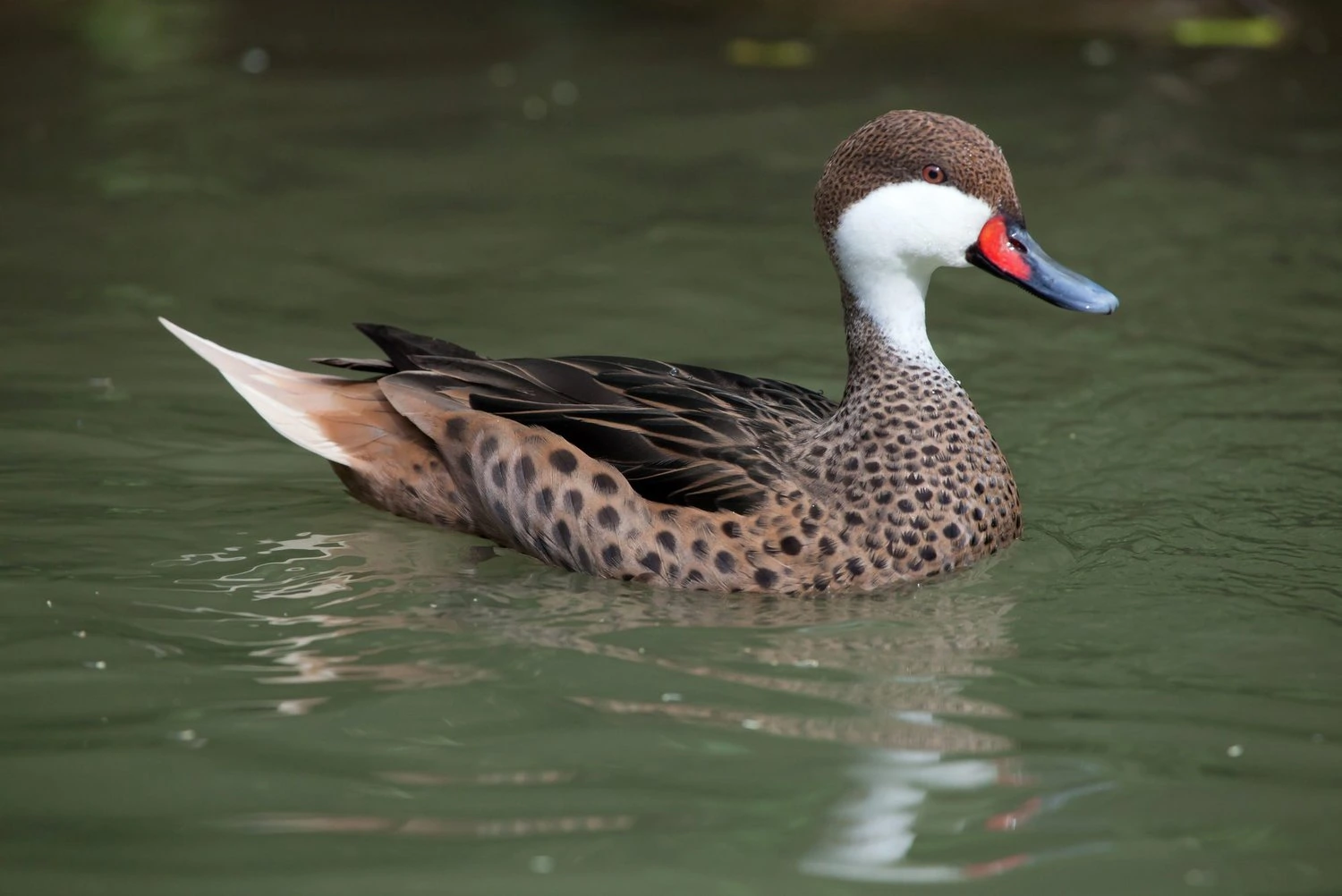
The White-cheeked Pintail is a dabbling duck that also goes by the name Bahama Pintail or summer duck.
White-cheeked Pintails are beautiful ducks. Both sexes look the same. They both have brown, streaked foreheads and napes. They have a white patch on their cheek extending to their throat. Their bills are blue with a distinct red spot at the base. The rest of their bodies are covered with black and brown spots.
- Anas Bahamensis
- Length: 18 – 20 in (46 – 51 cm)
- Weight: 19.2 oz (544 g)
- Wingspan: 26 – 31 in (66 – 79 cm)
White-cheeked Pintails are usually found in the Caribbean and South America, but they also are found in southeastern US states.
You can find White-cheeked Pintails in saltwater habitats, like lagoons, rocky or sandy seashores, and mangroves. They may also be found near rivers, lakes, and ponds. On rare occasions, they may be found in brackish water and shallow marshes.
White-cheeked Pintails dabble in water for food. They usually eat seeds, algae, aquatic plants, particularly widgeon plants, and small invertebrates.
White-cheeked Pintail Call:
Nests of White-cheeked pintails are made of leaves and hidden among tall grasses and weeds and located near the water. When the eggs hatch, the young are led by the female to a safe water environment.
18. Baikal Teal
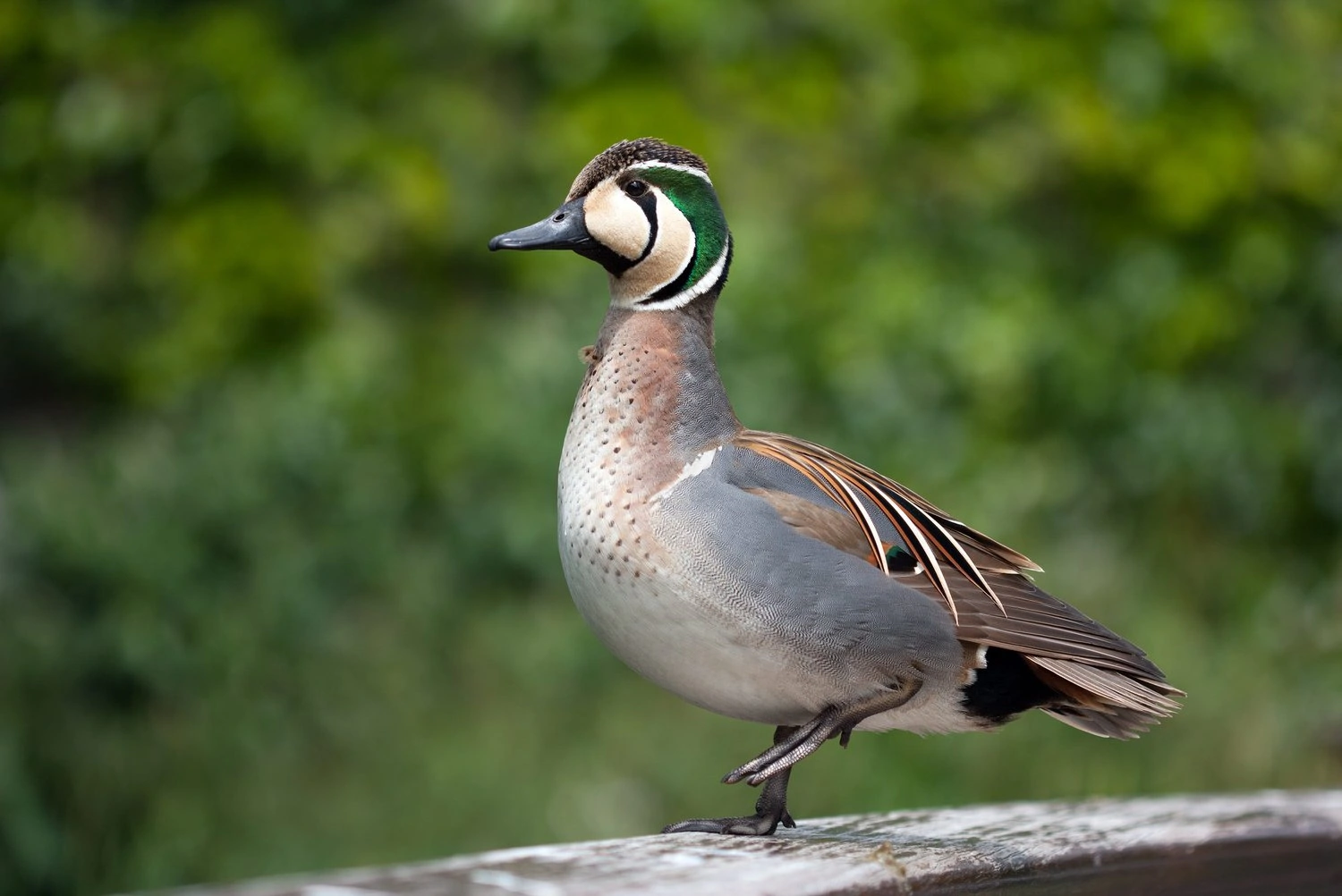
Baikal Teals are also called bimaculate ducks or squawk ducks. Male Baikal Teals are uniquely patterned ducks which makes it easy to recognize them. They have white, green, pale brown, and black-colored heads with a striking pattern.
Their breasts are spotted in a pinkish-brown color. Their sides are gray and outlined with vertical white stripes. Their backs are dark brown with a scallop pattern, and they have long, pointed feathers that cover their wings.
Females and juveniles share the same coloring – dark brown on the top half and light brown on the lower half of their bodies. Their breasts and flanks have a spotted pattern, while their back is more scalloped. Females have a distinct white spot at the base of their bills.
- Anas formosa
- Length: 15 – 17 in (38-43 cm)
- Weight: 15.4 oz (436 g)
- Wingspan: 20 – 25 in (51 – 64 cm)
Baikal Teals usually breed in eastern Siberia and winter in Asia, but they wander into the United States and Canada.
You can find Baikal Teals near swampy, tundra areas during the breeding season. They spend winter in freshwater areas like lakes, rivers, and reservoirs. They also favor farmlands where they feed at night.
Baikal Teals are dabbling ducks, so they feed on underwater plants and invertebrates simply by tipping their bodies into the water. They would normally eat aquatic plant seeds, snails, and algae. When on agricultural fields, they consume grains and seeds.
Baikal Teal Call:
Nests of Baikal Teals are often found on the ground, either near the base of a tree or a shrub or near the water. The nests are made out of dried plants and lined with feathers. The female lays six to ten eggs which take twenty-one to twenty-five days to hatch.
Fun Fact: Baikal Teals used to be classified as “Vulnerable” due to hunting before 2011, but their numbers are now recovering.

